
Serving Southwest Ohio and Northern Kentucky

info@TheBugBusters.net.
Attention Realtors and Loan Officers: Click the link for our online inspection sheet.
About Powder Post Beetles
PowderPost Beetles
Powderpost beetle is a term used to describe several species of wood-boring insects. Powderpost beetles are so called because in high numbers they can turn the inside of a piece of wood into nothing more than a mass of powder. They can do significant damage to log homes, furniture, wood floors and structural timbers. PowderPost beetles are small, and the adult beetles are seldom seen. Homeowners are more likely to see damage than the beetles themselves, because the adults are short-lived and are active mainly at night. Most of the life cycle is spent in the grub stage eating wood. This stage can last between 1-10 years depending upon several factors including species of beetle, type of wood infested, age of wood, moisture content of wood and air temperature. People do not realize that the wood is infested until the adult beetles emerge from within the wood. The exit holes are very small, about the size of a pin head. When the wood is tapped with a hammer dust will fall from these exit holes. Depending on the species, powderpost beetles can infest hardwoods such as cherry and oak, or softwoods such as poplar, pine, and bamboo. If you find a beetle infestation in a piece of oak furniture this same species of beetle would not infest your pine floor but might infest other pieces of your oak furniture. Infestations develop slowly, but wood can be re-infested year after year.
In attics and crawl spaces you may find old house borer damage also. This beetle is much bigger than the powderpost beetle and their exit holes are huge.
The three types of Powderpost Beetle that we see in our region:
Lyctidae
Adults are flattened, slender, reddish-brown to black, varying from 1/32 to 1/8 inch long. The abdominal segment is long, and the antenna bears a club of only two segments. The head is visible from above. Mature larvae are C-shaped, slightly hairy with three pairs of spine-like legs, and yellowish white with a brown head. The frass (digested wood) is a fine flour or talc-like and loosely packed in tunnels. Large quantities often fall out at exit holes and cracks. Lyctidaes feed primarily on hardwoods and are usually brought into buildings in lumber that has been stored in yards or at building sites. They may also be present in furniture, wood paneling, and firewood. Damage is usually to the starch-rich sapwood of large-pored hardwoods such as ash, hickory, oak, walnut, and cherry. The hardwood floors of new homes are commonly attacked.
Lyctidae (a.k.a true powderpost beetle) have a life cycle of 3 months to one year. They are reddish-brown to black and range from 1/32 to 1/8 inch in length
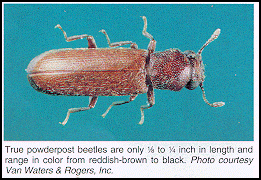
Adult Lyctidae
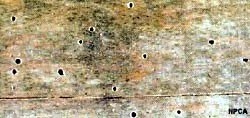
Evidence of infestation
Anodidae
Adult Anobiids have slender, cylindrical bodies, are reddish-brown to nearly black and range from 1/16 to 1/8 inch long. In most species, the head is bent downward. The widest point of the thorax is slightly forward of the base, tapering backward and appearing as a rough, diamond-shaped outline. Larvae are C-shaped and nearly white except for a dark head. The frass is fine to coarse and loosely packed in tunnels. Unlike Lyctidaes, this frass feels gritty to the touch. There is also a small amount of frass around the exit holes. Anobiids may attack both hardwoods and softwoods, which means that infestations may be found in all the same places as Lyctid beetles as well as in structural timbers (beams, sills, joists, studs, subflooring, etc.). Maple, beech, poplar, and pine are especially susceptible to attack. Anobiids prefer to infest wood which is damp; therefore, infestations usually begin in moist, poorly ventilated areas such as crawl spaces, basements, garages, and utility sheds. Under favorable conditions of moisture and temperature, infestations may spread upwards into walls and upper levels of the structure, including furniture. Infestations may occur because of using infested lumber, or from beetles flying in from outdoors or being carried in on firewood. Anobiids are called deathwatch beetles because in the past superstitious people believed the ticking one species makes foretold impending death in the household. Adult beetles make the sound during the mating season by tapping their heads on a hard surface. They attack seasoned softwood, hardwood, sapwood, and heartwood found in woodwork, flooring, structural wood, furniture, tool handles and sometimes firewood. Exit holes are round and 1/16 and 1/8 inch in diameter.
Anodidae (a.k.a furniture and deathwatch beetle) have a life cycle of one to three years. They are reddish-brown to black in color and range from 1/6 to 1/8 inch in length
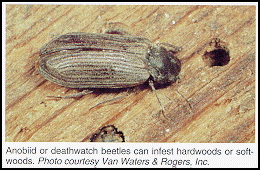
Adult Anodidae
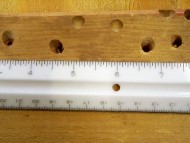
Evidence of infestation
Bostrichidae
Adult Bostrichids are cylindrical in most species, dark brown or black and range from 1/32 to 3/8 inch long. They have a roughened thorax. Antennae bear a club of three distinct segments. The head is usually not visible when viewed from above. Larvae are C-shaped; the body segments immediately behind the head capsule are much wider than the body segments at the rear. The frass is fine to coarse, tightly packed and tends to stick together. Bostrichids are the least common of the three here. They are found in baskets, picture frames, furniture, and other imported bamboo material.
These insects attack unseasoned and seasoned softwood, hardwood, and sapwood, and are often found in dying trees or recently fallen logs as well as seasoned lumber and wood products. Adults rarely reinfest wood. Adult exit holes are round and 3/32 to 9/32 inch in diameter. Both larvae and adults cause the damage.
Bostrichidae (a.k.a. false powderpost beetle) have a life cycle of approximately one year. They are dark brown to black in color and range in size from 1/32 to 3/8 of an inch
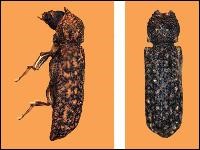
Adult Bostrichidae
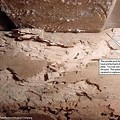
Evidence of infestation
Dayton, OH 45401-3151
Phone 937-256-6475
info@TheBugBusters.net
Powered by w3.css